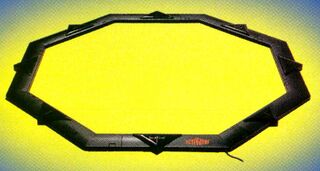Difference between revisions of "Activator"
From Sega Retro
Lukdriver14 (talk | contribs) m |
Lukdriver14 (talk | contribs) m |
||
| Line 61: | Line 61: | ||
}} | }} | ||
}} | }} | ||
| + | |||
| + | ==Magazine articles== | ||
| + | {{mainArticle|{{PAGENAME}}/Magazine articles}} | ||
==Physical scans== | ==Physical scans== | ||
Revision as of 11:38, 16 February 2019

| |||||||||||||||
| Activator | |||||||||||||||
|---|---|---|---|---|---|---|---|---|---|---|---|---|---|---|---|
| Made for: Sega Mega Drive | |||||||||||||||
| Manufacturer: Interactive Light, Sega | |||||||||||||||
|
The Activator is a full-body motion based video game controller unit released by Sega. It is an octagonal controller unit which sits on the floor and uses infra-red beams to interpret movements. It was revealed for the Sega Mega Drive console in 1993, intended to act as a more immersive substitute for a standard control pad.
In the arcades, similar technology was used for the Sega System 32 fighting game Dragon Ball Z V.R.V.S., which used extra sensors for better motion detection.
In Russia, sold since 1995 by Mikrodin-S.
Contents
Hardware
The Activator was created at a time where many video game companies were investing in virtual reality, perceived at the time to be the future of gaming. However, for the most part, virtual reality was considered to be too expensive to produce in homes at the time, so products such as the Activator were produced instead. The Activator was developed by Interactive Light for Sega, and was also brought to Brazil by Tec Toy. It was based on a musical instrument called the "Light Harp", conceived by musician and martial artist Asaf Gurner.
The Activator comes in eight segments, which when fitted together creates an octagonal ring which is designed to be placed on a floor. Each section of the Activator fires a beam of light upwards, and the player stands inside the octagon, "punching" and "kicking" to break the light beams and sending signals to the Mega Drive console in the process. The Activator is effectively a glorified control pad, with ![]() ,
, ![]() ,
, ![]() ,
, ![]() ,
, ![]() ,
, ![]() ,
, ![]() and START buttons mapped to each of the eight segments.
and START buttons mapped to each of the eight segments.
Sega of America marketed the Activator as a martial arts simulator, claiming that it improved the experience of fighting games. However, many argued the reverse was true, and many games which rely on fast reactions are not suitable for this style of control scheme at all. Furthermore, the light beams are easily distorted by a non-flat ceiling or obstructions such as beams of a ceiling fan or light fixture. As a result, the Activator did not see much commercial success and was retired mere months after launch.
An improved version of the Activator was used for the Sega System 32 arcade fighting game Dragon Ball Z V.R.V.S. It had a number of extra sensors to pull off better reaction sensing. Dragon Ball Z V.R.V.S. was a popular attraction at the Amusement Machine Show 1993 for its accurate motion detection and fun gameplay.[2][3] It was thus the first successful example of full-body motion sensing in a video game.
"Activated" games
While the Activator will function with any Mega Drive title, a small number of games were partially designed for the Activator and so specifically label themselves as "activated":
In addition, Sega of America promoted support for Mortal Kombat, Street Fighter II: Special Champion Edition and Streets of Rage 2. The Mega Drive and Sega 32X versions of Mortal Kombat II also mention the Activator by name, but the control scheme is identical to that of the standard three-button controller.
Unreleased games Air Drums and Bounty Hunter were designed specifically for the Activator and were meant to ship with the product, but were cancelled.
Promotional material
US Promotional Video
also published in:
- Electronic Gaming Monthly (US) #52: "November 1993" (1993-xx-xx)[4]
- Game Players (US) #0612: "Vol. 6 No. 12 December 1993" (1993-1x-xx)[5]
- Sega Visions (US) #16: "December/January 1993/1994" (1993-xx-xx)[6]
- GamePro (US) #54: "January 1994" (199x-xx-xx)[7]
- Mega Play (US) [8]
- Sega Visions (US) #17: "February/March 1994" (199x-xx-xx)[9]
- Electronic Gaming Monthly (US) #57: "April 1994" (1994-xx-xx)[10]
also published in:
- GamePro (US) #64: "November 1994" (1994-xx-xx)[11]
- Sega Visions (US) #22: "December/January 1994/1995" (1994-xx-xx)[12]
- Sega Visions (US) #23: "February/March 1995" (199x-xx-xx)[13]
- Sega Visions (US) #24: "May 1995" (1995-xx-xx)[14]
Magazine articles
- Main article: Activator/Magazine articles.
Physical scans
| Mega Drive, US (with Eternal Champions) |
|---|
References
- ↑ 1.0 1.1 File:GamePro US 052.pdf, page 204
- ↑ File:Edge UK 002.pdf, page 17
- ↑ File:EGM US 051.pdf, page 222
- ↑ Electronic Gaming Monthly, "November 1993" (US; 1993-xx-xx), page 278
- ↑ Game Players, "Vol. 6 No. 12 December 1993" (US; 1993-1x-xx), page 202
- ↑ Sega Visions, "December/January 1993/1994" (US; 1993-xx-xx), page 146
- ↑ GamePro, "January 1994" (US; 199x-xx-xx), page 42
- ↑ GamePro, "January 1994" (US; 199x-xx-xx), page 8
- ↑ Sega Visions, "February/March 1994" (US; 199x-xx-xx), page 10
- ↑ Electronic Gaming Monthly, "April 1994" (US; 1994-xx-xx), page 78
- ↑ GamePro, "November 1994" (US; 1994-xx-xx), page 133
- ↑ Sega Visions, "December/January 1994/1995" (US; 1994-xx-xx), page 3
- ↑ Sega Visions, "February/March 1995" (US; 199x-xx-xx), page 81
- ↑ Sega Visions, "May 1995" (US; 1995-xx-xx), page 85
External links
- Sega Activator Ring Instructional Video
- Sega Activator Demonstration at 1993 Winter CES
- U.S. Patent 5,045,687







